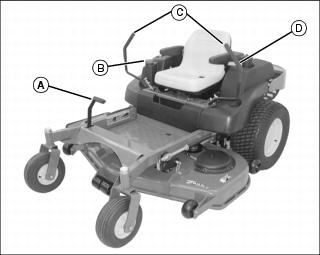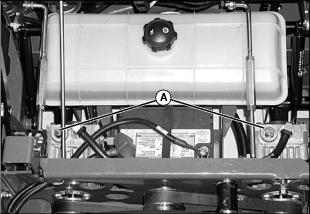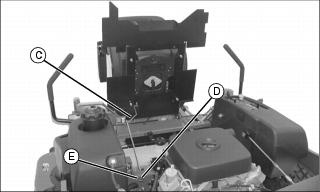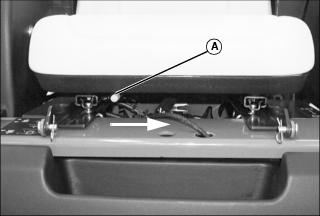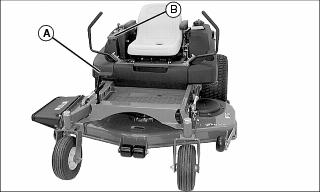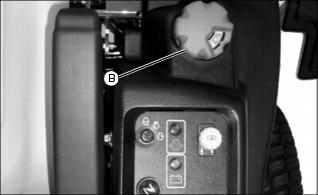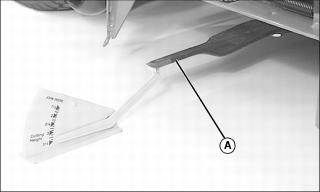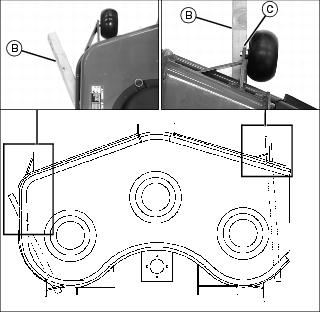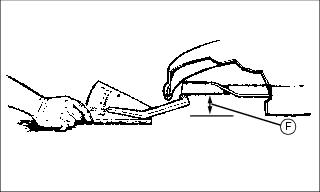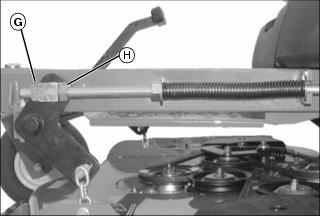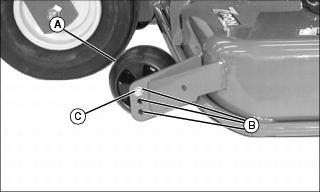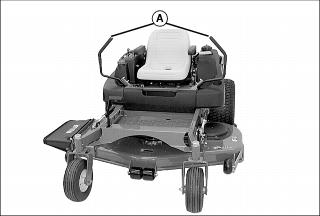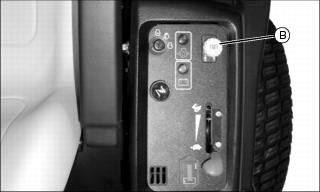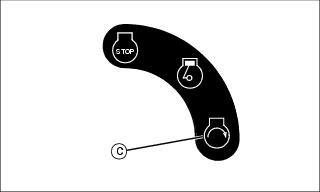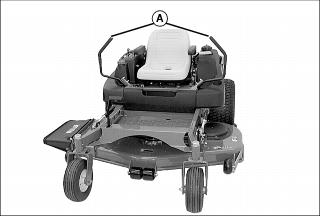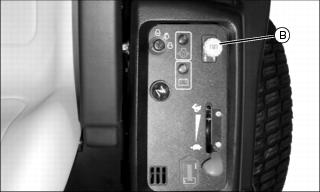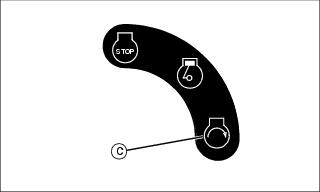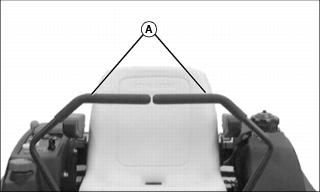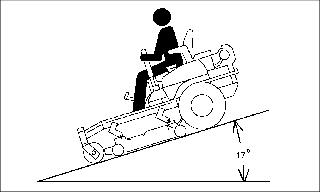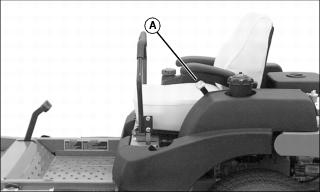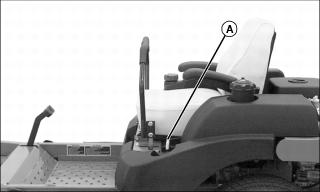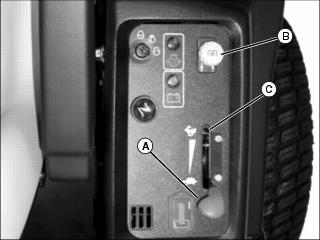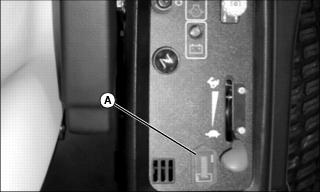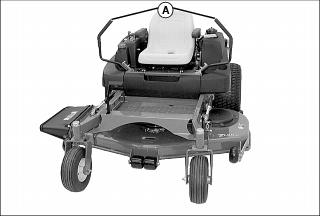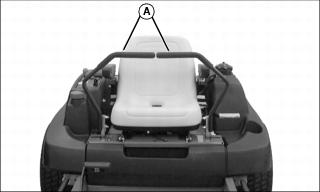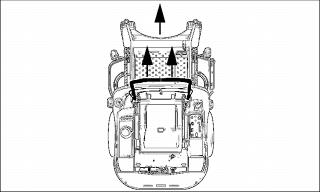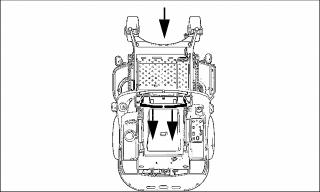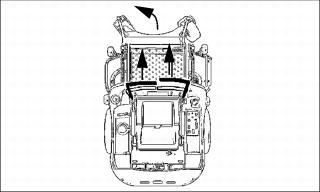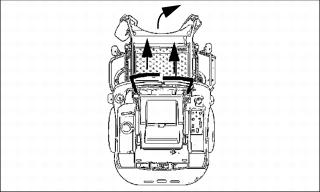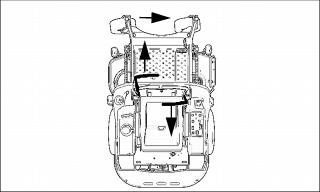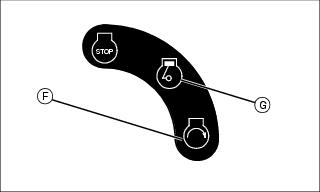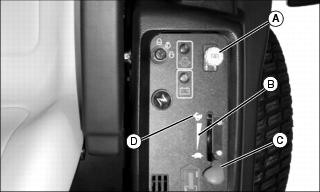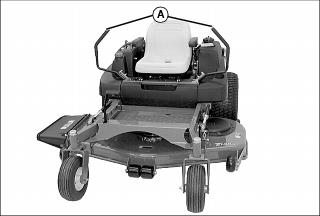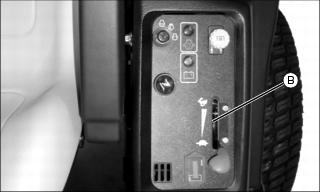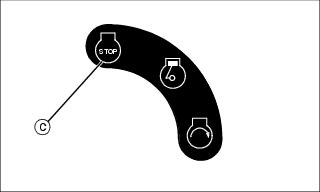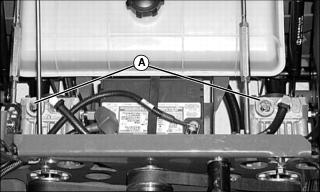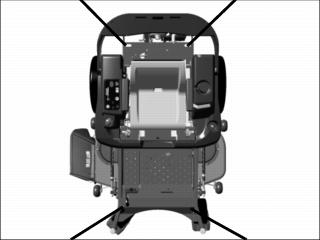Introduction
Product Identification
Safety
Operating
Avoid Damage to Plastic and Painted Surfaces
Mounting and Dismounting Machine Safely
Raising and Lowering Operator Seat
Adjusting Mower Deck Cutting Height
Adjusting Deck Lift Spring Tension
Adjusting Mower Deck Anti-Scalp Wheels
Using the Motion Control Levers
Using the Free-Wheeling Pump Release Valves
Replacement Parts
Service Intervals
Service Lubrication
Service Engine
Service Transmission
Service Steering & Brakes
Service Mower
Service Electrical
Service Miscellaneous
Troubleshooting
Storage
Assembly
Specifications
Warranty
John Deere Quality Statement
Service Record

Operating
Daily Operating Checklist
o Make sure all necessary guards and shields are safely and securely attached. Check for loose, missing, or damaged parts.
o Check engine oil level, hydraulic oil level and for oil leaks.
o Check mule and mower deck drive belts for damage or cracking.
o Adjust cutting height if necessary.
o Check tire pressure. Check tires for damage or cracking.
o Remove mower deck belt shields- inspect and clean grass and debris from belt area.
o Remove grass and debris from: Operator station foot plate, engine oil cooler fins (25 HP), engine blower fan screen, pump drive belt compartment, engine cooling fins, hydraulic pumps and pump mounting plate.
o Check and adjust steering control linkages.
Avoid Damage to Plastic and Painted Surfaces
· Do not wipe plastic parts unless rinsed first.
· Insect repellent spray may damage plastic and painted surfaces. Do not spray insect repellent near machine.
· Be careful not to spill fuel on machine. Fuel may damage surface. Wipe up spilled fuel immediately.
Operator Station Controls
Operator Station Controls
Miscellaneous Controls
A - Free-Wheeling Pump Release Valves
Mounting and Dismounting Machine Safely
Do not step on either side of the mower deck when mounting and dismounting the machine. Mount the machine from the front using foot plate (A). Park machine safely (See Parking Safely in the Safety section.) before dismounting.
Raising and Lowering Operator Seat
Raising the Seat
1. Park mower on a hard, level surface.
2. Stop engine and lock park brake.
NOTE: Seat platform latch is located on the left side of the engine.
3. Raise latch handle (A) to unlock seat latch (B).
4. Lift seat, stop rod (C) will travel in slotted frame hole (D).
5. When seat is fully raised, make sure stop rod tab (E) securely locks the seat in the raised position.
Lowering the Seat
1. Stand on the left side of the machine.
2. Move operator seat slightly forward and lift stop rod (C).
3. Slowly lower seat, stop rod (C) will travel in slotted frame hole (D).
Adjusting Seat
2. Push and hold the seat adjustment lever (A) toward the middle of the seat.
3. Slide forward or backward to desired position.
Adjusting Mower Deck Cutting Height
· The mower deck height adjustment consists of fifteen different cutting heights. The fifteen cutting heights range from 38-127 mm (1-1/2-5 in.) in 6.3 mm (1/4 in.) increments.
· Cutting height levels can be adjusted without leaving the operator seat.
Cutting Height Adjustment Procedure
1. Park machine on a hard, level surface.
3. Stop engine and lock park brake.
4. Step on the deck lift pedal (A) and hold it down.
5. Turn height-of-cut knob (B) to the desired setting.
Leveling Mower Deck
NOTE: Mower deck anti-scalp wheels should not contact the ground.
1. Park machine safely. (See Parking Safely in the Safety section.)
2. Inflate tires to the correct pressure.
3. Step on deck lift pedal and turn height-of-cut knob to the transport position.
· The transport position is the 127 mm (5 in.) cutting height position.
Checking Level (Side-to-Side)
NOTE: Mower deck anti-scalp wheels should not contact the ground.
1. Step on deck lift pedal and turn height-of-cut knob to the 76 mm (3 in.) cutting height position.
NOTE: Discharge chute raised to illustrate photo clarity.
2. Position left mower blade in the sideways (left to right) position.
NOTE: Use a short ruler or a leveling gauge to check the mower blade level.
3. Measure from outside blade tip to the ground.
4. Position right mower blade (A) (discharge side) in the side-to-side position.
5. Measure from outside blade tip to the ground.
· The difference between both measurements should be no greater than 3 mm (1/8 in.).
6. If side-to-side level is not within the given tolerance, an adjustment is necessary.
Adjusting Level (Side-to-Side)
1. Step on deck lift pedal and turn height-of-cut knob to the transport position.
· The transport position is the 127 mm (5 in.) cutting height position.
2. Place 76 mm (3 in.) wood blocks (B) under each side of the mower deck.
· The wood block placed under the left side of the mower deck must be positioned to the rear of the raised portion of the deck wall.
NOTE: The right front anti-scalp wheel must not rest on the wood block.
· The wood block placed under the right side of the mower deck must be positioned under the right front anti-scalp wheel bracket (C).
3. Lower mower deck down onto the wood blocks.
4. Step on deck lift pedal and turn height-of-cut knob to the 83 mm (3-1/4 in.) cutting height position.
5. Remove mule belt from clutch.
6. Loosen lift assist springs (D) on each side of machine to allow deck to sit flat.
7. Verify that cam follower located on rear lift shaft is in contact with height adjustment cam on lift system.
8. Adjust front and rear chain lengths (E) on each side of machine so there is no slack in links and deck is freely supported by the 76 mm (3 in.) wood blocks.
9. Step on deck lift pedal and turn height-of-cut knob to the transport position.
· The transport position is the 127 mm (5 in.) cutting height position.
10. Remove wood blocks from under both sides of the mower deck.
11. Step on deck lift pedal and turn height-of-cut knob to the 76 mm (3 in.) cutting height position.
12. Check side-to-side mower level. Repeat adjustment as needed.
Checking Level (Front-to-Rear)
1. Step on deck lift pedal and turn height-of-cut knob to the 76 mm (3 in.) cutting height position.
2. Position right mower blade (discharge side) in the straight forward (front-to-rear) position.
3. Measure from the right front blade tip to the ground.
4. Turn blade 180° and measure from right rear blade tip to the ground.
· The height (F) of the rear blade tip should be between 3 - 6 mm (1/8 - 1/4 in.) higher than the front blade tip.
5. If the front-to-rear level is not within the given tolerance, an adjustment is necessary.
Adjusting Level (Front-to-Rear)
NOTE: Adjust side-to-side mower level before adjusting front-to-rear level.
Adjust both sides of the mower deck equally.
1. Loosen jam nut (G) on each deck lift assist rod.
2. While positioned in front of the machine, adjust mower level:
· Turn hex nut (H) clockwise to lower front of mower deck.
· Turn hex nut (H) counterclockwise to raise front of mower deck.
3. Verify that the adjustment on right and left sides is equal.
5. Check front-to-rear mower level.
6. Install mule belt when all adjustments are made.
Adjusting Deck Lift Spring Tension
NOTE: Deck lift spring tension is adjusted at the factory. If the effort required to raise or lower the mower deck is not satisfactory, an adjustment may be necessary.
Check Spring Tension
1. Park machine on a hard, level surface.
2. Stop engine and lock park brake.
3. Step on deck lift pedal and turn height-of-cut knob to the transport position.
· The transport position is the 12.7 cm (5 in.) cutting height position.
4. Measure distance (A) between the washers (B) on each deck lift spring assembly.
· The recommended factory setting is 28 cm (11 in.).
Adjust Spring Tension
NOTE: Both deck lift spring assemblies must be adjusted equally.
Do not over tension the deck lift springs. If the springs are compressed too tightly, the mower deck will float too freely.
Decrease deck lift spring tension if operating in rough terrain.
While positioned in front of the machine:
· Turn hex nut (C) clockwise to increase deck lift spring tension and reduce the effort to raise and lower the mower deck.
· Turn hex nut (C) counterclockwise to decrease deck lift spring tension and increase the effort to raise and lower the mower deck.
Adjusting Mower Deck Anti-Scalp Wheels
NOTE: The flattest cut can be achieved by having all four anti-scalp wheels adjusted off the ground. Check anti-scalp wheel adjustments each time the mower deck cutting height is changed.
It is recommended that all four anti-scalp wheels be kept off the ground to minimize scuffing.
1. Check machine tire pressure. Inflate tires to the correct pressure.
2. Step on deck lift pedal and turn height-of-cut knob to the transport position.
· The transport position is the 12.7 cm (5 in.) cutting height position.
3. Adjust mower deck to desired cutting height.
4. Adjust anti-scalp wheel (A) to one of three positions (B).
· Remove hex bolt (C), nylock nut and washer.
· Adjust wheel up or down so it is approximately
6-13 mm (1/4-1/2 in.) above the mowing surface.
5. Install wheel with attaching hardware.
6. Adjust all wheels to the same height.
Testing Safety Systems
Use the following checkout procedures to check for normal operation.
If there is a malfunction during one of these procedures, Do not operate machine. (See your John Deere dealer.)
Perform these tests in a clear open area. Keep bystanders away.
Testing PTO Switch
1. Sit on the operator's seat with the motion control levers in the neutral lock position.
3. Pull PTO switch (B) up to engage.
4. Turn key switch to the start position (C).
Testing Park Brake Switch
1. Sit on the operator's seat with the motion control levers (A) in the neutral lock position.
2. Push PTO switch (B) down to disengage.
4. Turn key switch to the start position (C).
Testing Neutral Start Switch
NOTE: Repeat this test three times, with the motion control levers in the following positions:
1. Right side motion control lever inward.
2. Left side motion control lever inward.
3. Both motion control levers inward.
1. Move motion control lever(s) inward to the neutral position (A).
3. Push PTO switch (B) down to disengage.
4. Turn key switch to the start position (C).
Testing Seat Switch
3. Pull PTO switch up to engage.
4. Raise slightly off the seat.
Testing the Park Brake
1. Stop machine on a 17° slope (30% grade). Stop the engine and lock the park brake.
Using the Park Brake
Always lock the park brake and remove the key before leaving the machine unattended. |
Locking Park Brake
· Raise park brake lever (A) to lock park brake.
Unlocking Park Brake:
· Lower park brake lever (A) to unlock park brake.
Using the PTO Knob
Engage PTO:
1. Move throttle lever (A) to the 1/2 to 3/4 fast position.
2. Pull PTO knob (B) up to engage mower deck.
3. Move throttle lever (A) forward to the fast position (C) for mowing.
Disengage PTO:
Using the Throttle Lever
· Push throttle lever (A) all the way forward to the fast position (D) when mowing.
· Move throttle lever (A) to the half throttle position (C) when starting and warming the engine.
· Pull throttle lever (A) to rear to slow position (B) to idle engine. Do not run engine at slow idle any longer than necessary.
Using the Hour Meter
NOTE: The machine is equipped with an electric start. The hour meter will continue to run with the key switch left in the run position.
· The hour meter (A) shows number of hours the machine has run.
· The service interval chart gives necessary service intervals. Use the hour meter and service interval chart to determine when machine will need service.
Using the Motion Control Levers
The functions of the motion control levers are:
· Dual function neutral position.
Neutral Lock Position
Picture Note: Motion control levers shown in the neutral lock position.
· Motion control levers (A) must be in the neutral lock position and the park brake locked to start the engine.
· Forward and reverse movement of the motion control levers is prevented when levers are moved to the neutral lock position.
· Operator can exit mower with the engine running when the PTO switch is disengaged, the motion control levers are in the neutral lock position and the park brake is locked.
· Motion control levers must be in the neutral lock position to safely enter and exit the operator seat.
Neutral Position
Picture Note: Motion control levers (A) shown in the neutral position.
· Machine speed, motion, and direction can be controlled when the engine is running, motion control levers are in the neutral position, and the park brake is unlocked.
Forward and Reverse Motion:
1. Move throttle lever to the fast position.
3. Move both motion control levers from the neutral lock position inward to the neutral position.
4. Push the control levers forward to begin forward motion.
· The further forward the control levers are moved, the faster the machine will travel.
· Forward speed range:0-14.5 km/h (0-9.0 mph).
5. Pull both control levers rearward at the same time to begin reverse motion.
· Reverse speed range: 0-6.4 km/h (0-4 mph).
6. To stop motion, move both motion control levers forward or rearward until the machine comes to a stop.
NOTE: The motion control linkages are adjustable. If adjustment is required see Checking and Adjusting Motion Control Linkages in the Service-Transmission section.
Forward:
· Push both motion control levers forward at the same time.
Reverse:
· Pull both control levers past center rearward at the same time.
Gentle Left Turn:
· Push right control lever further forward than the left control lever.
Gentle Right Turn:
· Push left control lever further forward than the right control lever.
Sharp Left Turn:
· Push right control lever forward and pull left control lever rearward at the same time.
Sharp Right Turn:
· Push left control lever forward and pull right control lever rearward at the same time.
Starting the Engine
1. Move both motion control levers (A) to the neutral lock position.
2. Sit on the operator's seat.
4. Push the PTO switch knob (D) down to disengage the PTO.
5. Move throttle lever (E) to set engine speed:
· Cold engine: Pull knob up to the choke position.
· Warm/Hot engine: If necessary, pull knob up to the choke position.
7. Turn key switch to the start position (F).
8. Release key to the run position (G) when the engine starts.
· Push choke knob to the off position.
· Move throttle lever to the fast position.
Engaging Mower
2. Move throttle lever (C) to the 1/2-3/4 throttle position (B).
4. Move both motion control levers to the neutral position.
5. Pull PTO knob (A) up to engage mower deck.
6. Move throttle lever to the fast position (D).
7. Push motion control levers forward slowly. Mow at a safe travel speed.
Stopping the Engine
1. Move the motion control levers (A) to the neutral lock position.
3. Move throttle lever to the 1/2 fast position (B).
4. Turn key switch to STOP position (C).
Using the Free-Wheeling Pump Release Valves
IMPORTANT: Avoid damage! Transmission damage may occur if the machine is moved or towed incorrectly: |
NOTE: The free-wheeling pump release valves must be fully turned clockwise (closed) during normal vehicle operation.
When the machine needs to be moved without starting the engine, use the free-wheeling pump release valves:
2. Lift and secure operator seat platform in the raised position.
3. Turn both free-wheeling pump release valves (A) counterclockwise approximately 1/4 turn.
6. Push machine to desired location. Due to hydraulic system drag, machine will move slowly.
Transporting Machine
IMPORTANT: Avoid damage! Transmission damage may occur if the machine is moved or towed incorrectly: |
Use a heavy-duty trailer to transport your machine. Trailer must have signs and lights required by law.
1. Step on deck lift pedal and turn height-of-cut knob to the transport position.
· The transport position is the 127 mm (5 in.) cutting height position.
2. Drive machine onto a trailer.
3. Stop engine and lock park brake.
5. Fasten machine to trailer with heavy-duty straps, chains, or cables. Both front and rear straps must be directed down and outward from machine as shown.
Mowing Tips
· Mow grass with throttle lever in the full fast position.
· Keep mower deck and discharge chute clean.
· Properly level mower deck for a smooth cut.
· Use a travel speed that fits the conditions:
· Mow tall or wet grass twice. Cut grass at half desired height - then cut at desired height.
· Travel slow when mowing tall, thick or wet grass.
· Avoid damaging grass by slipping or skidding machine drive wheels. Practice smooth control lever movements.
· When performing sharp turns, do not allow inside machine drive wheel to stop and twist on grass.
Mowing Travel Speeds
· Normal mowing on level ground.
Dismounting to Inspect Mower
1. Park machine on a hard, level surface.
2. Push knob down to disengage PTO.
3. Move motion control levers to the neutral lock position.
5. Stop engine and remove key. Wait for mower blades to stop turning before leaving operator's seat.


